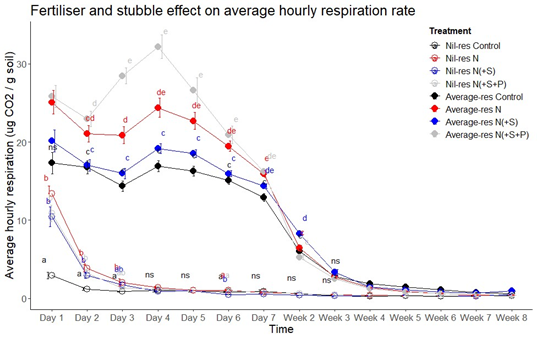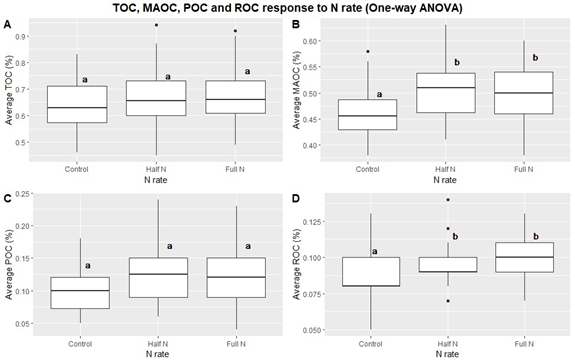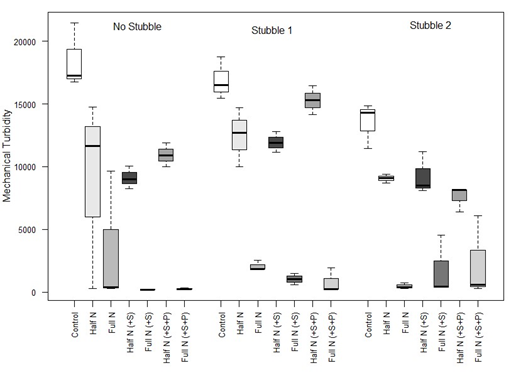Fertilise the farming system not just the crop to build soil organic matter – the impact of nutrient stoichiometry on carbon sequestration in dispersive subsoils
Author: Andrew Regan (UNE/CSIRO), Chris Guppy (UNE), Brian Wilson (UNE), John Kirkegaard (CSIRO), Alan Richardson (CSIRO) | Date: 14 Feb 2024
Take home messages
- Recent research found a novel method to increase soil C in cropping systems by adding nutrients (N, P, S) to incorporated crop stubble at the theoretical rate required by soil microbes for growth
- The practice has produced variable results and has not been tested specifically on sodic soils which could benefit significantly from improved carbon sequestration
- Our research demonstrates that soil C losses could be reduced, rather than significant soil C sequestered by supplementary nutrients added to stubble on a dispersive soil which was accompanied by improved aggregate stability
- A new GRDC funded project led by CSIRO seeks to verify the soils and strategies where post-harvest fertiliser applications to crop residues can increase soil C.
Background
Sequestering carbon in agricultural soils improves crop productivity and contributes to offsetting greenhouse gas emissions (Lal, 2011). The balanced application of N, P and S in combination with stubble incorporation into topsoil is a novel strategy to increase soil C in cropping systems (Kirkby et al., 2016; Kirkegaard, 2023). The stable form of soil C (mineral-associated organic C (MAOC)) was found to have a specific C:N:P:S ratio of 10,000:833:200:143. Therefore, applying fertiliser to crop stubbles to achieve the microbial demand for these nutrients has potential to improve stabilisation of soil C.
A common misconception is that nutrients are lost/wasted when applied to soil in the fallow period however ‘fertilising the system’ meets the microbial demand for nutrients when stubble is decomposing which can result in greater stabilisation of C and the nutrients later become available to the crop. This concept requires further research to determine the soils/environments, seasonal conditions, and timing where it is beneficial and economical.
Study one – PhD project (2019-2025)
A PhD project aimed to build on previous research by exploring this input strategy in a dispersive subsoil. Dispersive subsoils benefit from the application of organic matter (Uddin, et al., 2022) so it is possible that dispersion could be further reduced by stubble incorporation and the co-application of nutrients.
Incubation 1 – Short-term study
Method. The study comprised a laboratory incubation experiment to assess the impact of stubble, stubble quality and supplementary nutrients (N, P, S) on microbial activity and soil C changes. Two sorghum stubble of different quality (C:N ratio of 36 and 43) were applied to soil at an equivalent rate of 4 t/ha. Nitrogen was applied to each at three rates; Control (0 kg N/ha), half rate required to balance the stoichiometry (55 kg N/ha) and full rate (110 kg N/ha). Sulfur alone (20 kg S/ha), and sulfur plus phosphorus at 30 kg/ha were added to both the half N and full N treatments to determine the value of providing S and P in addition to N.
The incubation experiment was run for 8 weeks in 70 mL jars each containing 25 g of soil in cabinets at 22°C. During the course of the experiment hourly CO2 respiration was recorded over the full 8- week period and at the end of the experiment samples of soil were taken to measure changes in soil C fractions including total organic C (TOC), mineral-associated organic C (MAOC), particulate OC (POC) and recalcitrant OC (ROC) using a mid-infrared spectrometer.
Results. The pattern of respiration over the course of the 8-week period is shown in Figure 1 for the control and the average of both of the residue treatments (very little difference between stubble types). The application of stubble increased respiration by soil microbes and under the higher N rate soil respiration was increased (Figure 1). When the stubble and N were supplemented with S alone there was a small and transitory reduction in respiration during the first week, while S and P generated a small increase in respiration.

Figure 1. The effect of stubble and fertiliser treatment addition on average hourly respiration rate during the 8-week incubation.
The application of stubble appeared to increase soil C fractions (Figure 2) but only the MAOC and ROC fractions had significant increases (Figure 2B, D). It seems likely much of the added stubble C was consumed and respired as CO2. Under the higher N rate soil respiration was higher (Figure 1) but a similar amount of MAOC was stabilised (Figure 2B). When N was supplemented with S and P there was no significant change in soil C fractions despite the transitory changes in respiration.

Figure 2. Changes in soil C fractions in response to added stubble and nitrogen
Incubation 2 – Longer-term effects on aggregate stability
Method. The experiment involved a 6-month incubation designed to investigate the impacts of similar treatments to those in Incubation 1 on the longer-term soil structural stability. Treatments were applied to 70 mL containers with 25 g soil and treatments identical to those in Incubation 1. Stability was assessed at the end of the incubation by measuring (1) Spontaneous turbidity, which is a measure of the physicochemical stability of a soil; (2) Mechanical turbidity, which incorporates kinetic energy into the measurement, simulating the action of raindrop impact; and (3) Zeta potential, which integrates the important role of cation valence and ionic strength (salinity) on aggregate stability. The higher in magnitude the zeta potential the greater the soils tendency to disperse.
Results. Spontaneous turbidity (ST) declined by 60% with the addition of stubble in the absence of nutrients with little difference between stubble types (Figure 3). Nutrients alone reduced ST to an even greater degree than stubble with the full N (+S or S+P) treatment generally providing the greatest reduction in turbidity with or without stubble.

Figure 3. Effect of stubble and nutrient treatments on spontaneous turbidity after 6 month incubation of a dispersive soil.
Similar trends were observed for mechanical turbidity although stubble alone had less effect while the effect of the full N rate, with or without S and P was exceptional, reducing turbidity to zero (Figure 4).

Figure 4. Effect of stubble and nutrient treatments on mechanical turbidity after 6 month incubation of a dispersive soil.
Discussion
The incubation studies have demonstrated that both stubble retention and N, P and S supplied as fertiliser increased microbial respiration and prevented C losses in a dispersive subsoil under laboratory conditions. The results coincided with improved aggregate stability, which suggests this management practice may be an effective tool on other dispersive soils and in a field setting. The results suggest stubble quality can affect decomposition and C content so testing of stubble may be required to establish appropriate fertiliser rates rather than relying on generalised assumptions. The impact of N rate appeared to have a greater effect than S and P, but this may change depending on initial soil S and/or P content. Dispersion processes are highly sensitive to ionic strength, a soil chemist’s term for salinity. This is part of the reason small rates of gypsum can reduce dispersion before they have fully dissolved. In this study, fertiliser application itself, particularly N increased soil ionic strength enough to limit dispersion significantly. In incubation studies, the applied fertiliser is contained. However, these effects, if not stabilised through the incorporation of the added N into organic matrices, will be short-lived as the fertiliser leaches through field soil.
Study two – New GRDC project (2023–2027)
A national-scale field project has been established to build on significant national and international research demonstrating the importance of nutrient supply (NPS), not just C, in the correct ratios to build and maintain soil organic matter (SOM) in productive agricultural systems.
The initial proof-of-concept conducted at CSIRO was confirmed in recent experiments (Kirkby et al., 2016; Sevenster et al., 2020; Kirkegaard et al., 2023) where a long-term trend of declining SOM under no-till farming was arrested and reversed within 5 years by adopting novel nutrient supply strategies.
This field-based proof-of-concept in a long-term tillage experiment at Harden NSW, showed significant increases in SOM could be achieved in productive and profitable systems by adopting this approach – however further refinements to nutrient timing, rates, formulations, and delivery may provide further improvements to reduce risk of C loss, increase profit and avoid nutrient loss.
This project will assess 10 different nutrient supply strategies in fully replicated (4) on-farm field experiments, starting January, 2023 at 8 sites on contrasting soils and environments across Australia including Narrabri NSW (black soil); Young NSW (granite/red brown); Corowa NSW (red brown); Wimmera VIC (grey clay);Keith SA (alkaline loam); Tarlee SA (red brown); Cuballing WA (sand over gravel); Moora WA (deep sand). The treatments include different levels of incorporation, granular and liquid fertiliser and comparison of fertiliser applied to the stubble or to the crop.
Baseline sites with replicated experiments have been established and baseline soil C sampling done in 2023 along with on-farm strip trials. The sites will be managed through a 5-year crop sequence with treatments applied to stubble annually. At the conclusion of the 5-year experimental period, the data collected on crop productivity, gross margins, and changes in soil C from small plot and paddock strips will be used to develop cost-benefit analysis including sensitivity analysis with respect to C, fertiliser and grain prices.
References
Kirkby CA, Richardson AE, Wade LJ, Conyers M and Kirkegaard JA (2016) Inorganic Nutrients Increase Humification Efficiency and C-Sequestration in an Annually Cropped Soil, PLoS One, 11(5), https://doi.org/10.1371/journal.pone.0153698Kirkegaard, 2020).
Kirkegaard JA, Richardson AE, and Kirkby CA (2023) Fate and Cost Effectiveness of Soil Carbon Sequestered Using Supplementary Nutrients Applied to Crop Residues Under Field Conditions, Nutrient cycling in agroecosystems 143
Lal R (2011) Sequestering carbon in soils of agro-ecosystems, Food policy, Vol.36 (1), p.S33-S39
Sevenster M, Luo Z, Eady S, Grant T (2020) Including long-term soil organic carbon changes in life cycle assessment of agricultural products, Int J Life Cycle Assess 25, 1231–1241 (2020).
Uddin S, Williams SW, Aslam N, Fang Y, Parvin S, Rust J, Van Zwieten L, Armstrong R, Tavakkoli E (2022), Ameliorating Alkaline Dispersive Subsoils with Organic Amendments: Are Productivity Responses Due to Nutrition or Improved Soil Structure? Plant and soil 227
Acknowledgements
Supervisors: Chris Guppy and Brian Wilson. With assistance from John Kirkegaard and Alan Richardson at CSIRO.
The research undertaken as part of this project is made possible by the significant contributions of growers through both trial cooperation and the support of the GRDC, the author would like to thank them for their continued support.
Contact details
Andrew Regan
UNE / CSIRO
School of Environmental & Life Sciences, UNE
Ph: 0427 872 329
Email: aregan3@myune.edu.au
Date published
February 2024
GRDC Project Code: CSP2302-011RTX,
Was this page helpful?
YOUR FEEDBACK
